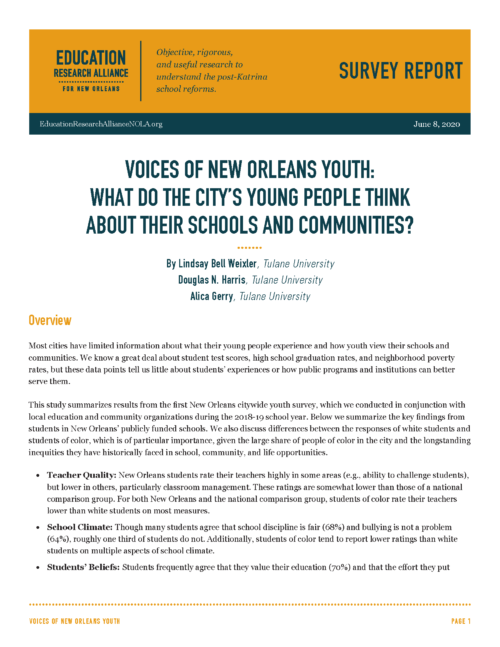Voices of New Orleans Youth: What Do the City's Young People Think About Their Schools and Communities?
A new study by Lindsay Bell Weixler, Douglas N. Harris, and Alica Gerry examines how students view their teachers, schools, and communities.

Voices of New Orleans Youth: What Do the City's Young People Think About Their Schools and Communities?
Published
by Lindsay Bell Weixler, Douglas N. Harris, Alica Gerry
Most cities have limited information about what their young people experience and how youth view their schools and communities. We know a great deal about student test scores, high school graduation rates, and neighborhood poverty rates, but these data points tell us little about students’ experiences or how public programs and institutions can better serve them. This study summarizes results from the first New Orleans citywide youth survey, which we conducted in conjunction with local education and community organizations during the 2018 – 19 school year. Below, we summarize the key findings from students in New Orleans’ publicly funded schools. We also discuss differences between the responses of white students and students of color, which is of particular importance, given the large share of people of color in the city and the longstanding inequities they have historically faced in school, community, and life opportunities. — Teacher Quality: New Orleans students rate their teachers highly in some areas (e.g., ability to challenge students), but lower in others, particularly classroom management. These ratings are somewhat lower than those of a national comparison group. For both New Orleans and the national comparison group, students of color rate their teachers lower than white students on most measures. — School Climate: Though many students agree that school discipline is fair (68%) and bullying is not a problem (64%), roughly one third of students do not. Additionally, students of color tend to report lower ratings than white students on multiple aspects of school climate. — Students’ Beliefs: Students frequently agree that they value their education (70%) and that the effort they put into their schoolwork pays off (71%). Consistent with national trends, they have high ambitions, with 85% reporting that they will pursue a college degree. One of the few areas in which we find that schools’ state-assigned letter grade relates to students’ responses is in college aspirations: students in A and B schools are more likely to believe that they will go to college, compared to students in lower-rated schools. — Transportation: Most students (70%) report school commutes of less than 30 minutes. — Neighborhoods: New Orleans youth frequently report having social support (67%) and feeling safe in their neighborhoods (72%). 44% participate in service activities in their communities, with students of color more likely to participate than white students. The majority of white students report feeling safer in the presence of police, while the majority of black students do not. Having input from the city’s youth is invaluable in understanding how they experience their schools and neighborhoods, and we are excited to be able to highlight their voices. These results offer insight into how we, as a city, are serving our children. In instances where these results suggest there are concerns in our schools and communities, we acknowledge that these are complicated issues. There are many possible contributing factors, as well as many avenues to address them. We hope the results from this survey will prompt new conversations and provide a call to action to improve the lives of New Orleans’ young people.
Related Publications
Do Charter Schools Keep Their Best Teachers and Improve Quality? Retention and Rewards for Teachers in New Orleans
Mar 9, 2020 | by Nathan Barrett, Deven Carlson, Douglas N. Harris, Jane Arnold Lincove
Can Text Messages Help Families Applying for Early Childhood Education Programs?
Apr 15, 2019 | by Lindsay Weixler, Jon Valant, Daphna Bassok, Justin B. Doromal, Alica Gerry
The Effects of the New Orleans School Reforms on Exclusionary Discipline Practices
Mar 18, 2019 | by Mónica Hernández

